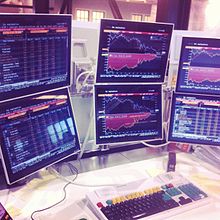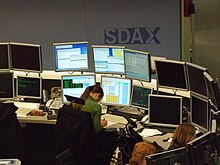
A graphics card is a computer expansion card that generates a feed of graphics output to a display device such as a monitor. Graphics cards are sometimes called discrete or dedicated graphics cards to emphasize their distinction to integrated graphics processor on the motherboard or the CPU. A graphics processing unit (GPU) that performs the necessary computations is the main component in a graphics card, but the acronym "GPU" is sometimes also used to erroneously refer to the graphics card as a whole.

In computer science, multiple buffering is the use of more than one buffer to hold a block of data, so that a "reader" will see a complete version of the data instead of a partially updated version of the data being created by a "writer". It is very commonly used for computer display images. It is also used to avoid the need to use dual-ported RAM (DPRAM) when the readers and writers are different devices.

The RIVA TNT2 is a graphics processing unit manufactured by Nvidia starting in early 1999. The chip is codenamed "NV5" because it is the 5th graphics chip design by Nvidia, succeeding the RIVA TNT (NV4). RIVA is an acronym for Real-time Interactive Video and Animation accelerator. The "TNT" suffix refers to the chip's ability to work on two texels at once. Nvidia removed RIVA from the name later in the chip's lifetime.

A KVM switch is a hardware device that allows a user to control multiple computers from one or more sets of keyboards, video monitors, and mice.
In computing, hardware overlay, a type of video overlay, provides a method of rendering an image to a display screen with a dedicated memory buffer inside computer video hardware. The technique aims to improve the display of a fast-moving video image — such as a computer game, a DVD, or the signal from a TV card. Most video cards manufactured since about 1998 and most media players support hardware overlay.

The ATI Rage is a series of graphics chipsets developed by ATI Technologies offering graphical user interface (GUI) 2D acceleration, video acceleration, and 3D acceleration developed by ATI Technologies. It is the successor to the ATI Mach series of 2D accelerators.
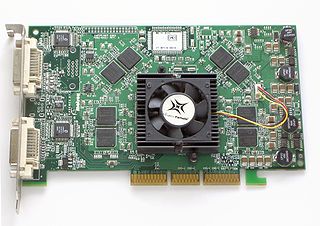
The Matrox Parhelia-512 is a graphics processing unit (GPU) released by Matrox in 2002. It has full support for DirectX 8.1 and incorporates several DirectX 9.0 features. At the time of its release, it was best known for its ability to drive three monitors and its Coral Reef tech demo.
The G400 is a video card made by Matrox, released in September 1999. The graphics processor contains a 2D GUI, video, and Direct3D 6.0 3D accelerator. Codenamed "Toucan", it was a more powerful and refined version of its predecessor, the G200.

A multiseat, multi-station or multiterminal system is a single computer which supports multiple independent local users at the same time.
Matrox Graphics eXpansion Module (GXM) supports the use of multiple monitors over a single video source by splitting the output of a video source, providing an enlarged workspace or gaming environment. GXM is not a graphics card itself, and in fact requires a fairly powerful graphics card for playing games on multiple monitors.

A video wall is a special multi-monitor setup that consists of multiple computer monitors, video projectors, or television sets tiled together contiguously or overlapped in order to form one large screen. Typical display technologies include LCD panels, Direct View LED arrays, blended projection screens, Laser Phosphor Displays, and rear projection cubes. Jumbotron technology was also previously used. Diamond Vision was historically similar to Jumbotron in that they both used cathode-ray tube (CRT) technology, but with slight differences between the two. Early Diamond vision displays used separate flood gun CRTs, one per subpixel. Later Diamond vision displays and all Jumbotrons used field-replaceable modules containing several flood gun CRTs each, one per subpixel, that had common connections shared across all CRTs in a module; the module was connected through a single weather-sealed connector.

DisplayLink is a semiconductor and software technology company owned by Synaptics that develops the DisplayLink USB graphics technology. This technology enables computers and displays to connect using USB, Ethernet, and WiFi, and also allows for multiple displays to be connected to a single computer. DisplayLink's primary customers include notebook OEMs, LCD monitor manufacturers, and PC accessory vendors, and their technology is compatible with a wide range of operating systems, including Microsoft Windows, macOS, Android, ChromeOS, and Linux.

The Cromemco Dazzler was a graphics card for S-100 bus computers introduced in a Popular Electronics cover story in 1976. It was the first color graphics card available for microcomputers. The Dazzler was the first of a succession of increasingly capable graphics products from Cromemco which, by 1984, were in use at 80% of all television stations in the U.S. for the display of weather, news, and sports graphics.

The Voodoo2 is a set of three specialized 3D graphics chips on a single chipset setup, made by 3dfx. It was released in February 1998 as a replacement for the original Voodoo Graphics chipset. The card runs at a chipset clock rate of 90 MHz and uses 100 MHz EDO DRAM, and is available for the PCI interface. The Voodoo2 comes in two models, one with 8 MB RAM and one with 12 MB RAM. The 8 MB card has 2 MB of memory per texture mapping unit (TMU) vs. 4 MB on the 12 MB model. The 4 MB framebuffer on both cards support a maximum screen resolution of 800 × 600, while the increased texture memory on the 12 MB card allows more detailed textures. Some boards with 8 MB can be upgraded to 12 MB with an additional daughter board.
Adaptive tile refresh is a computer graphics technique for side-scrolling video games. It was most famously used by id Software's John Carmack in games such as Commander Keen to compensate for the poor graphics performance of PCs in the early 1990s. Its principal innovation is a novel use of several EGA hardware features to perform the scrolling in hardware. The technique is named for its other aspect, the tracking of moved graphical elements in order to minimize the amount of redrawing required in every frame. Together, the combination saves the processing time that would be otherwise required for redrawing the entire screen. Carmack designed the software engine based on a scrolling display for large images from the 1970s.
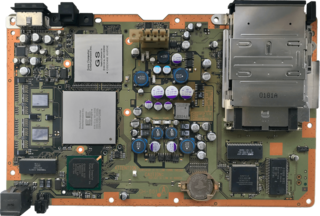
The PlayStation 2 technical specifications describe the various components of the PlayStation 2 (PS2) video game console.
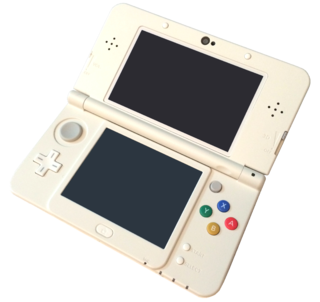
A stereoscopic video game is a video game which uses stereoscopic technologies to create depth perception for the player by any form of stereo display. Such games should not be confused with video games that use 3D game graphics on a mono screen, which give the illusion of depth only by monocular cues but lack binocular depth information.

AMD Eyefinity is a brand name for AMD video card products that support multi-monitor setups by integrating multiple display controllers on one GPU. AMD Eyefinity was introduced with the Radeon HD 5000 Series "Evergreen" in September 2009 and has been available on APUs and professional-grade graphics cards branded AMD FirePro as well.

scrcpy is a free and open-source screen mirroring application that allows control of an Android device from a desktop computer. The software is developed by Genymobile SAS, a company which develops Android emulator Genymotion.

Dual input or dual point user input are common terms describing the 'multiple touch input on two devices simultaneously' challenge.


